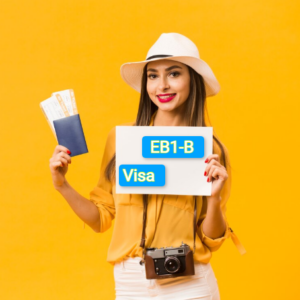Step-by-Step Guide to Applying for an EB1-B Visa

Step-by-Step Guide to Applying for an EB1-B Visa
The EB1-B visa is a highly sought-after employment-based immigration choice for professional researchers and scholars. Unlike the EB1-A visa, which lets people file a self-petition, the EB1-B calls for employer sponsorship. This visa offers a simplified way to permanent residence for those who can show extraordinary ability or research success.
Covering eligibility requirements, necessary papers, and processing times, this article describes the whole process for the EB1-B visa. It also explores how premium processing might speed your petition, advice for a strong application, and the variations between EB1A and EB1B.
What is the Visa EB1-B?

The EB1-B visa is a part of the first-choice employment-based immigration classification. It is especially meant for academics and researchers known as outstanding in their specialty. The applicant should have a permanent work offer from a U.S. company—such as a university, research center, or private company doing advanced research.
Important EB1-B Visa Characteristics Include:
- No labor certification is needed.
- High acceptance rates for qualified applicants, hence improving the EB1-B approval rate, relative to other employment-based visas.
- Relative speedier processing timeframes than other employment-based visas.
To choose the ideal route, applicants sometimes compare EB1A vs EB1B vs EB1C. EB1-A permits self-petition and covers broader categories; EB1-B is more specialized for academic and research-oriented staff.
How EB1-B Compares to EB1-C
While the EB1-C targets multinational executives and managers, the EB1-B is perfect for academics and researchers.
Key Comparisons:
- Eligibility: EB1-C calls for business leadership experience; EB1-B emphasizes academic success.
- Job Offer: While EB1-C petitions usually involve global companies, both groups call for an employer sponsor.
- Processing Times: Though EB1-B premium processing can speed up results, on the other hand, both categories have similar times.
Eligibility Criteria for EB1-B
Applications for the EB1-B green card must satisfy particular criteria established by USCIS. Included are:
-
First-rate Research or Academics
In your subject of study, you have to show a history of globally acknowledged achievements.
-
Permanent Job Offer
Unlike the EB1-A class, the EB1-B calls for an employer to sponsor your application. The employment offer has to be for either a teaching or permanent research post.
-
Approaching USCIS Criteria
Six criteria for the EB1-B visa have been developed by USCIS. To qualify you have to meet at least two of these:
- Author of Scholarly Articles: Evidence of notable research resulted in credible publications.
- Membership in Prestigious Associations: Proof of belonging to companies demanding exceptional performance.
- Contributions to the Field: Proof of major contributions to your field of knowledge.
- Judging the Work of Others: Invites you to evaluate colleagues in your field of expertise.
- Acknowledgment of Work: Published works of others mentioning your own.
- Major Award Receipt: Proof of noteworthy honors for services to your field.
Meeting these requirements is essential and many candidates ask for legal help to properly present their case.
Detailed Guide for Applying for an EB1-B Visa
-
Evaluate Your Eligibility
Review your credentials first against the EB1-B criteria USCIS. Make sure you have an employer ready to sponsor your application and satisfy a minimum of two of the six USCIS criteria.
-
Employer Files Form I-140
Your U.S. company needs Form I-140, Immigrant Petition for Alien Worker filed on your behalf. This petition shows that you fit the EB1-B category.
Important things to keep in mind:
- Add thorough records of your employment credentials and successes.
- For regular processing, the EB1-B I-140 processing time falls between six and nine months.
-
Compile Supporting Documentation

Your petition needs strong proof to satisfy USCIS criteria. Usually, acceptable bona fide marriage documents consist of:
• Published studies and references.
• Memberships in renowned companies.
• Employer reference letters and job offer details.
• Proof of honors and distinctions.
-
Think About Premium Processing
EB1-B premium processing is a great choice for individuals looking for quicker decisions. USCIS guarantees a decision within 15 calendar days for an extra cost using premium processing.
Track Processing Timelines
Managing expectations requires an awareness of the EB1-B processing time:
• Regular I-140 processing: Six to nine months.
• Status Adjustment (I-485): Most situations call for 8 to 14 months.
• Consular Processing: Varies depending on nation and case complexity.
Exploring Alternative Filing Strategies
To raise their chances of approval, applicants should think about several ways to submit their EB1-B petition.
Premium Processing
Using EB1-B premium processing can clear your I-140 petition decision in just 15 calendar days, therefore accelerating your decision. Although this alternative does not ensure acceptance, it greatly shortens waiting time so that applicants may proceed faster.
Consular Processing
Consular processing is an alternative to adjustment of status if you are outside the United States. For certain applicants, this path—which calls for working with a U.S. embassy or consulate—involves more interviews and documentation but can be faster.
Transitioning from H1B to EB1-B
Transposing to an EB1-B is a frequent and appropriate next step for long-term residency if you currently hold an H1B visa.
Differences Between H1B and EB1-B:
- Temporary vs. Permanent: H1B is a non-immigrant visa; EB1-B provides a straight route to a green card.
- No Annual Cap for EB1-B: The EB1-B category is not governed by an annual lottery system, unlike H1B.
Advice for a Seamless Transfer:
- Highlight Your Research and Academic Contributes: Show how your time on an H1B visa has helped you to shine in your field.
- Seek Employer Support: Work with your company to ready a strong case for sponsorship under the EB1-B category.
Extended Advantages of an EB1-B Green Card
Getting EB1-B green cards has major benefits:
- Freedom to Change Employers: EB1-B green card holders can change employment without risking their residency, unlike H1B green card holders.
- Path to Citizenship: After five years of green card holder status, you could be eligible for U.S. citizenship.
- Family Benefits: Green cards can also be applied for by your spouse and children under 21, therefore guaranteeing family unity.
Tips for a Successful EB1-B Application

-
Highlight Your Success
Make sure your petition highlights your profile’s finest points—such as awards, citations, and noteworthy publications.
-
Offer Detailed Proof
Combining letters of recommendation, employer endorsements, and third-party recognition will help you build a case.
-
Collaborate with a Professional
An immigration lawyer can help to make sure your application satisfies the high requirements needed for acceptance.
Timelines and Approaches of Processing
Several factors affect the EB1-B green card processing time, including if premium processing is applied.
| Step | Processing Time |
| I-140 Regular Processing | Six to nine months. |
| I-140 Premium Processing | Fifteen calendar days |
| Adjustment of Status (I-485) | 8-14 months. |
| Consular Processing | Varies by case and location. |
Why Select EB1-B Instead of Other Categories?
-
Streamlined Process:
Eliminating labor certification will help to simplify application processes.
-
Higher Approval Rates:
Comparatively to several other employment-based categories, the EB1-B approval rate is greater.
-
Faster Pathway to Residency:
Faster choices like EB1-B premium processing allow applicants to acquire permanent residency more quickly than with other visa kinds.
Particularly for researchers and academics, EB1 vs H1B clearly shows which is the better option for long-term residency.
Role of Immigration Attorneys in Your EB1-B Application

Working with a competent immigration attorney is sometimes the difference between success and failure in an EB1-B application.
Advantages of Legal Counsel:
- Document Review: Lawyers can point up evidence gaps and suggest more information.
- Personalized Strategies: They can make your application highlight your assets.
- Support for Complex Cases: Legal knowledge is quite helpful for candidates with odd situations.
Conclusion
For brilliant academics and teachers hoping for permanent residency in the United States, the EB1-B green card is a great choice. Understanding the EB1-B visa requirements, compiling strong proof, and applying using methods like premium processing can help you simplify your application procedure and raise your chances of approval.
Contact Passage Immigration Law now for professional help with your EB1-B application. Our knowledgeable staff specializes in effectively and successfully assisting professionals with immigration.
